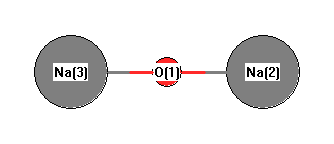Jump to
S1C2
Energy calculated at CCSD(T)/aug-cc-pVQZ
| | hartrees |
|---|
| Energy at 0K | -398.891763 |
| Energy at 298.15K | -398.892727 |
| HF Energy | -398.561847 |
| Nuclear repulsion energy | 61.844127 |
The energy at 298.15K was derived from the energy at 0K
and an integrated heat capacity that used the calculated vibrational frequencies.
Geometric Data calculated at CCSD(T)/aug-cc-pVQZ
Point Group is D∞h
Cartesians (Å)
| Atom |
x (Å) |
y (Å) |
z (Å) |
|---|
| O1 |
0.000 |
0.000 |
0.000 |
| Na2 |
0.000 |
0.000 |
2.023 |
| Na3 |
0.000 |
0.000 |
-2.023 |
Atom - Atom Distances (Å)
| |
O1 |
Na2 |
Na3 |
| O1 | | 2.0235 | 2.0235 |
Na2 | 2.0235 | | 4.0469 | Na3 | 2.0235 | 4.0469 | |
 More geometry information
More geometry information
Calculated Bond Angles
| atom1 |
atom2 |
atom3 |
angle |
|
atom1 |
atom2 |
atom3 |
angle |
| Na2 |
O1 |
Na3 |
180.000 |
|
Electronic energy levels
Charges, Dipole, Quadrupole and Polarizability
Jump to
S1C1
Energy calculated at CCSD(T)/aug-cc-pVQZ
| | hartrees |
|---|
| Energy at 0K | -398.891763 |
| Energy at 298.15K | -398.893121 |
| HF Energy | -398.561858 |
| Nuclear repulsion energy | 61.852867 |
The energy at 298.15K was derived from the energy at 0K
and an integrated heat capacity that used the calculated vibrational frequencies.
Geometric Data calculated at CCSD(T)/aug-cc-pVQZ
Point Group is C2v
Electronic energy levels
Charges, Dipole, Quadrupole and Polarizability
